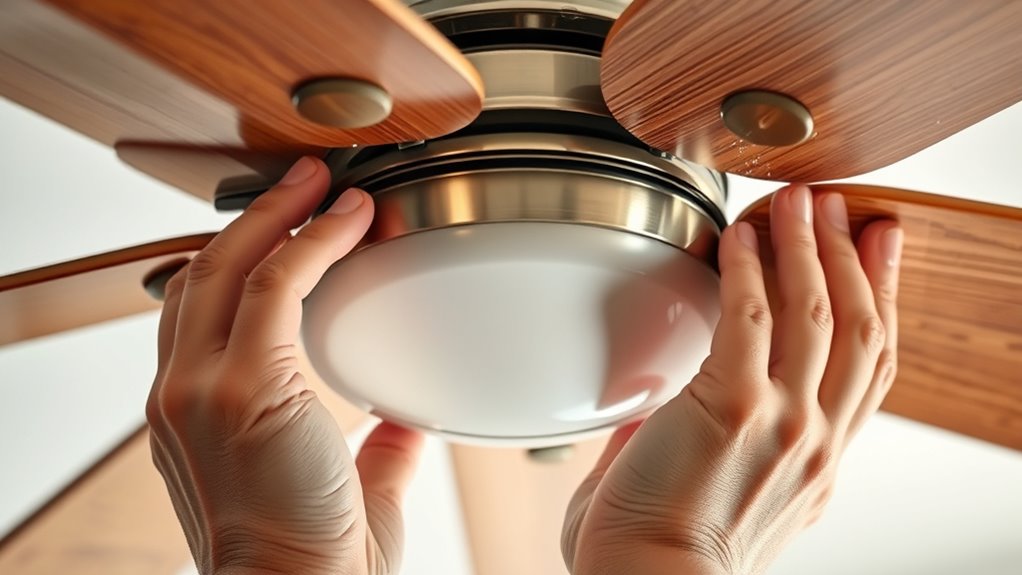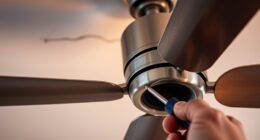After cleaning your ceiling fan blades, you’ll need to check and re-establish proper balance. Turn off the fan and observe for wobbling or vibrations at low speed. Use a balancing kit or small weights, like adhesive or fishing weights, to correct any imbalance by attaching them near the blade tips or roots. Incrementally adjust and test after each correction until the fan operates smoothly, quietly, and with minimal vibration. Continuing will reveal detailed steps to maintain ideal performance.
Key Takeaways
- Turn off the fan and inspect blades for warping, chips, or dirt after cleaning.
- Use a level or balancing kit to detect wobbling and identify unbalanced blades.
- Place small weights or objects at blade tips to test for imbalance and observe wobble reduction.
- Attach adhesive weights symmetrically near blade roots or tips, adjusting incrementally for balance.
- Recheck fan stability at low speed, ensuring smooth operation and secure weight attachment.

Balancing ceiling fan blades is essential to guarantee smooth operation and reduce noise, preventing uneven wear on the motor. After cleaning, slight shifts in blade weight distribution may occur due to accumulated dust, debris, or moisture removal, which can disrupt the fan’s balance. To ensure ideal performance, you must assess and correct any imbalance promptly. Begin by turning off the fan and letting the blades come to a complete stop. Use a level or a specialized fan balancing kit to detect any wobbling or uneven motion during operation. If the fan still exhibits vibrations or noise, the next step involves inspecting each blade individually for irregularities such as warping, chips, or accumulated dirt that may have altered their weight distribution.
Once the blades are thoroughly cleaned and inspected, you need to determine which blade or blades are causing imbalance. Place a small, lightweight object like a coin or a piece of masking tape near the tip of each blade, one at a time, and observe the fan’s behavior as it spins slowly. If the wobble diminishes when a particular blade is weighted, that blade is likely unbalanced. Conversely, if the wobble remains unaffected, the issue may lie elsewhere. To correct the imbalance, you can add small weights—such as adhesive weights or fishing weights—at the blade’s tip, or remove weight from the affected blade if you notice uneven wear or damage. It’s important to attach weights symmetrically on the underside of the blade, close to the root, to achieve proper balance.
If you have a fan balancing kit, follow the manufacturer’s instructions, which usually involve attaching balancing clips with weights and rotating the blades to test for improvements. Adjust the weights incrementally until the wobbling subsides. It’s vital to double-check the overall balance after each adjustment by turning the fan on at low speed and observing its movement. Ensure all weights are securely attached, as loose weights can cause further imbalance or damage. Regular maintenance, including periodic cleaning and rebalancing, prolongs the lifespan of the motor and blades, reduces operational noise, and maintains energy efficiency. Keep in mind that a well-balanced ceiling fan not only operates smoothly but also minimizes mechanical stress, preventing premature component failure. Proper blade balancing after cleaning guarantees optimal function, extending the longevity of your fan and ensuring safe, quiet operation.
Frequently Asked Questions
How Often Should I Balance My Ceiling Fan Blades?
You should balance your ceiling fan blades whenever you notice wobbling, unusual noise, or uneven airflow. Regular checks every few months help maintain proper function and reduce wear on the motor. If you perform cleaning, inspect and balance blades afterward to prevent imbalance caused by dust buildup or slight warping. Prompt balancing guarantees efficient operation, minimizes noise, and prolongs the lifespan of your fan.
Can Unbalanced Blades Cause Ceiling Fan Motor Damage?
Yes, unbalanced blades can cause ceiling fan motor damage. When blades are uneven, the motor works harder to maintain stability, increasing wear and tear. This added strain can lead to overheating or premature motor failure. To prevent damage, you should regularly check for balance and correct any imbalance promptly. Properly balanced blades guarantee smooth operation, reduce motor stress, and extend your fan’s lifespan.
What Tools Are Best for Balancing Fan Blades?
You should use a blade balancing kit, which includes a weighted plastic or metal clip and a small adjustable weight. Alternatively, a simple household item like a penny or coin can serve as a temporary weight. To balance the blades, attach the weight to the blade’s tip, then run the fan to observe vibrations. Adjust the weight position until the fan operates smoothly, minimizing wobble and noise.
Do All Ceiling Fans Require Balancing After Cleaning?
Not all ceiling fans require balancing after cleaning. For example, if your fan wobbles slightly during operation, it might need rebalancing. However, cleaning alone rarely causes imbalance unless debris or dust alters blade weight distribution. You should inspect for wobbling signs post-cleaning and only balance if vibrations are noticeable. Proper maintenance includes regular cleaning and periodic checks, but balancing is only necessary when an imbalance affects performance or safety.
Is Professional Balancing Necessary for Ceiling Fans?
Professional balancing isn’t always necessary for ceiling fans, but it’s recommended if you notice persistent wobbling or noise. If your fan operates smoothly after cleaning and inspection, you can often balance it yourself using a balancing kit. However, if imbalance issues continue, a professional technician can accurately diagnose and correct blade misalignments or structural problems, ensuring peak performance and safety.
Conclusion
Balancing your ceiling fan blades ensures smooth operation, much like aligning gears in a precision machine. When blades are properly balanced, the fan runs quietly and efficiently, preventing unnecessary wear. Conversely, unbalanced blades cause wobbling and noise, resembling a spinning top losing momentum. By maintaining proper blade balance, you create a stable environment, where functionality meets durability—transforming a simple fixture into a finely tuned piece of equipment. Proper balancing is vital for peak performance and longevity.








